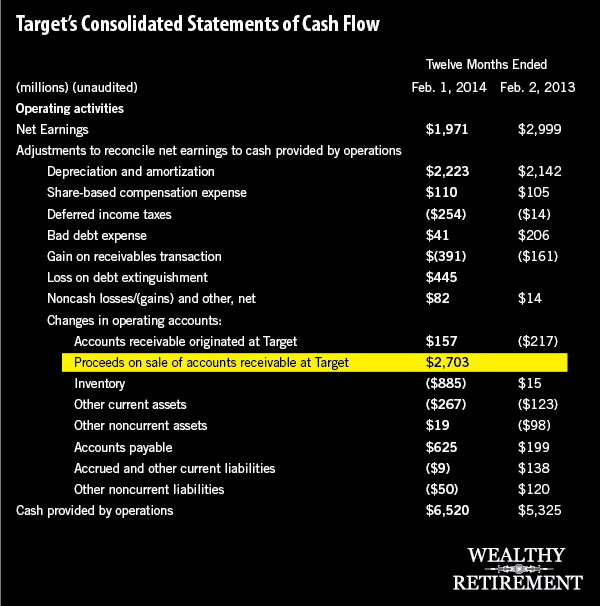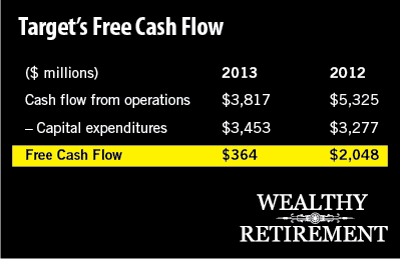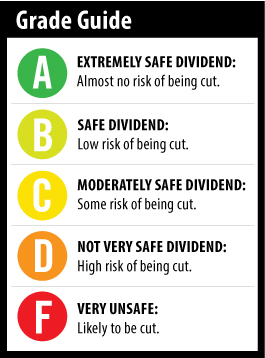 I’m not a fan of the experience at Target (NYSE: TGT). Although my wife shops there, I try to avoid it. The one closest to my house has an odd smell, like popcorn butter mixed with some kind of chemical cleaner. Hopefully, it’s not what they use on the popcorn.
I’m not a fan of the experience at Target (NYSE: TGT). Although my wife shops there, I try to avoid it. The one closest to my house has an odd smell, like popcorn butter mixed with some kind of chemical cleaner. Hopefully, it’s not what they use on the popcorn.
The company’s dividend is another story. There’s a lot to like there, which will probably sit well with Herman, who asked me to take a look at the stock this week.
But like the aroma at my local Target, not everything at the company is hunky-dory.
[ad#Google Adsense 336×280-IA]Earnings have not been great at Target.
In fiscal 2013, which ended February 1 of this year, net income fell 34% to $1.97 billion from $3 billion.
Lower margins and higher depreciation and amortization expenses caused the decline.
More importantly, cash flow isn’t as healthy as it appears.
When it comes to analyzing the safety of a dividend, cash flow is a better indicator than earnings.
Cash flow represents the actual amount of cash that the company took in. Earnings are often a manufactured number, where sales and expenses can be manipulated in order to manage Wall Street’s expectations.
It’s harder to fool around with cash flow. If the money comes in to the company, it is recorded. If cash is not received, it doesn’t find its way to the cash flow statement.
In 2013, Target generated $6.5 billion in cash flow from operations, $1.2 billion more than the year prior.
How did it make $1 billion less profit but generate over $1 billion more in cash flow?
Let’s take a look at the statement of cash flows.
 The key item here is that in March 2013, Target sold off its credit card business, taking in $2.7 billion.
The key item here is that in March 2013, Target sold off its credit card business, taking in $2.7 billion.
That was a game changer for its cash flow statement. However, it was a one-time event. So to accurately gauge whether Target can pay its dividend, we’re going to remove it from our calculation.
After subtracting the proceeds from the sale of its Target credit card receivables, cash flow from operations falls to $3.817 billion, substantially less than last year’s total.
But I’m not done yet. Capital expenditures (capex) is not included in cash flow from operations, though I would argue it should be. Capex is the money a company spends to buy and maintain equipment, buildings and real estate.
In 2013, Target spent $3.453 billion on capex, a bit higher than the $3.277 billion from a year ago.
We subtract capex from cash flow from operations to give us free cash flow. If you’ve followed me for any time, you know that free cash flow is the most accurate figure that tells us if the company makes enough cash to pay the dividend.
 When we take out the one-time $2.7 billion event, free cash flow is a paltry $364 million, compared to $2.05 billion last year.
When we take out the one-time $2.7 billion event, free cash flow is a paltry $364 million, compared to $2.05 billion last year.
In 2013, Target paid $1.006 billion in dividends or nearly three times as much free cash flow as was generated. In 2012, the $2.048 billion in free cash flow was more than enough to cover the $869 million in dividends.
So last year’s free cash flow is a concern.
But going forward, Wall Street predicts Target will generate $1.9 billion in free cash flow, which will be enough to cover the dividend. That number is expected to rise to $2.6 billion in 2015 and $3.5 billion in 2016.
46 Years and Counting
Target also has an excellent track record when it comes to paying and raising its dividend. It is a member of the esteemed Dividend Aristocrats – S&P 500 companies that have raised the dividend every year for at least 25 years.
In Target’s case, the track record is 46 years. It first started raising the dividend in 1967 and has done so every year since.
Certainly, at some point in the past 46 years, the company had a dip in free cash flow, yet found a way to continue to raise the dividend.
And its annual dividend increases have been huge. Over the past 10 years, the average annual hike was 20%. That includes 20% raises in each of the past three years.
If free cash flow remains tight, Target could tap on the brakes of its increases, perhaps only raising the dividend by 5% until the cash flow situation reverses.
I’m not suggesting the company will do that, only that it can if necessary to keep its annual increase streak alive.
 Typically, companies like Target, with long histories of raising the dividend every year, do whatever it takes to keep those track records intact.
Typically, companies like Target, with long histories of raising the dividend every year, do whatever it takes to keep those track records intact.
The free cash flow issue is a concern, but with the company’s track record I think there is almost no chance it cuts the dividend.
Worst case scenario – if free cash flow goes negative for a couple of years, the company maintains the dividend but doesn’t raise it.
Even in 2008, when free cash flow was negative, Target raised the dividend 14% in 2008 and 6% in 2009.
I can’t see a situation where Target cuts the dividend in the near to intermediate future.
Dividend Safety Rating: A
— Marc Lichtenfeld
[ad#DTA-10%]
Source: Wealthy Retirement
